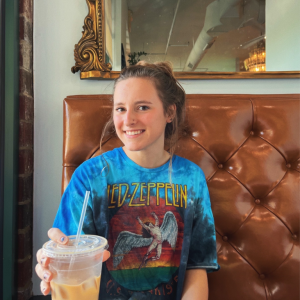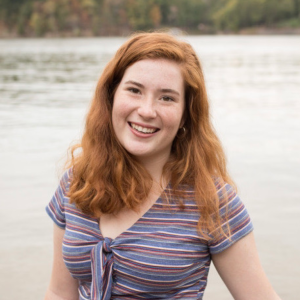We are reflecting on the sustainable semester we’ve had this fall at Carolina. This semester, we’ve worked with students via a capstone course and the EcoStudio internship program. Through experiential education opportunities like these, students hone their skills and use them to advance campus sustainability.
E3P Capstone Course Final Presentations

Léda Van Doren’s students arrived to their final presentations with impressive insights.
At the beginning of the semester, Van Doren selected Sustainable Carolina as the client for her Capstone course. Led by Sustainability Analyst Melanie Elliott, students examined water and energy usage in campus buildings. At the end of the course, students could submit proposals to be considered for the Champion Sustainability Fund.
The class worked in three different groups: electricity, HVAC/steam/chilled water, and water. Each group began by examining building data provided by Sustainable Carolina. Elliott guided students throughout the process, explaining how Sustainable Carolina collects data and how it can be used to identify outliers. Outliers include buildings that seem to be using very little or too much of a resource. Identifying outliers is crucial in creating a more efficient campus.
The students’ final presentations featured a building outlier, along with strategies for improving efficiency.
The group focused on steam usage scheduled a tour of their outlier with building staff, during which they discovered challenges that weren’t obvious through data alone. This underscored the need for investigation into outliers. The water use intensity group initiated conversations about water recycling systems to conserve water. And lastly, the group examining electricity made big strides in connecting athletics to sustainability efforts.
EcoStudio Internships
 Mikayla Cummings, Greening Campus Labs
Mikayla Cummings, Greening Campus Labs
Mikayla Cummings worked with Sustainability Director Cindy Shea to raise awareness about UNC Green Labs. The campus-wide program works with researchers, lab managers, students, faculty, and administrators to encourage sustainability in Carolina’s labs.
During the semester, Cummings met with different labs across campus to better understand their needs. With this background, she designed a phone app, which is currently in development at the UNC App Lab.
The app will help lab members easily track their progress in completing the Green Labs Certification Checklist. The checklist includes tasks under categories like waste reduction, equipment and energy efficiency, resource conservation, and campus engagement. By completing the categories, labs can earn different levels of certification.
Cummings also disseminated information on the Efficient Freezer Rebate Program, financed by the Renewable Energy Special Projects Committee (RESPC). She put up posters and talked to labs about the program, which incentivizes the purchase of more efficient freezers.
Ultimately, Cummings hopes to pursue an M.D./MPH, and implement sustainability, environmental justice, and public health into medical research. She values the service aspect of medicine, having worked as a hospital volunteer in La Paz, Bolivia.
 Allison Kelker, Pandemic Impacts & the Greenhouse Gas Inventory
Allison Kelker, Pandemic Impacts & the Greenhouse Gas Inventory
Allison Kelker worked with Sustainability Analyst Melanie Elliott to analyze how the pandemic impacted campus greenhouse gas emissions. More specifically, she worked to determine which emissions reductions resulted from effort-based reductions and which resulted from pandemic-based reductions. Effort-based reductions include any strategies deliberately made by the University to decrease emissions. Pandemic-based reductions include emissions reductions caused by a decrease in typical campus operations.
Kelker began by constructing a research methodology, breaking down GHG emissions into categories — flights, transportation, commuting, food, combustion, and purchased electricity. From there, she focused on combustion and purchased electricity. Effort-based and pandemic-based reductions led to a decrease in emissions from these sources.
Sustainable Carolina released its Climate Action Plan in the middle of the pandemic. With a more accurate view on emissions reductions caused by the University’s efforts versus the pandemic’s effects, we will be able to update the “Strategies to Carbon Neutrality by 2040” graphs found in the plan.
During final presentations, Kelker noted that one of the most interesting things about the project was how she was able to bring her own insights in as a student.
“I was living on campus in 2021 and noticed a lot of things about the University and its operations from a student side that I was able to bring into the analysis,” she said. “Melanie knew about the upper-level operations. I think we were both able to mesh our ideas together.”
